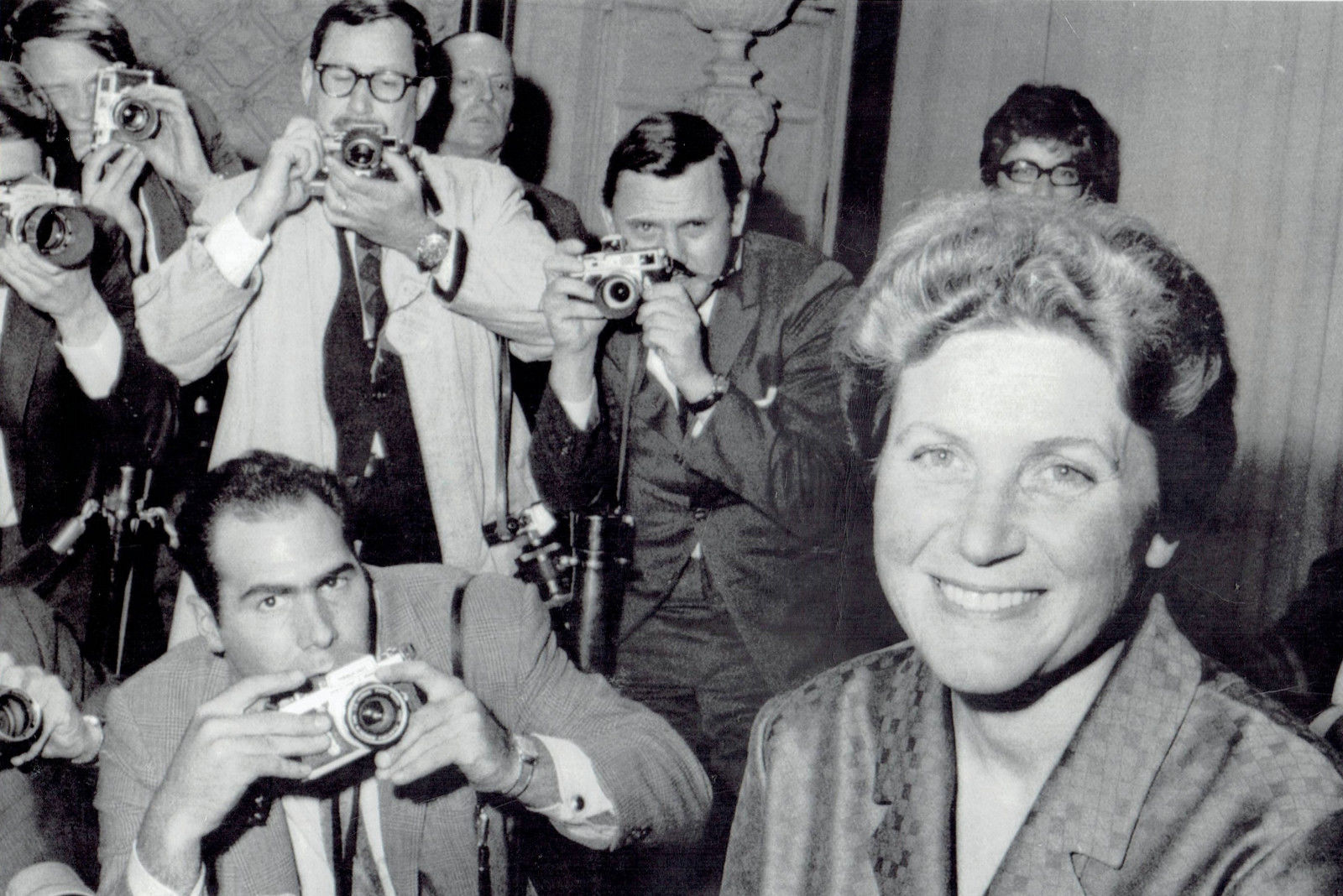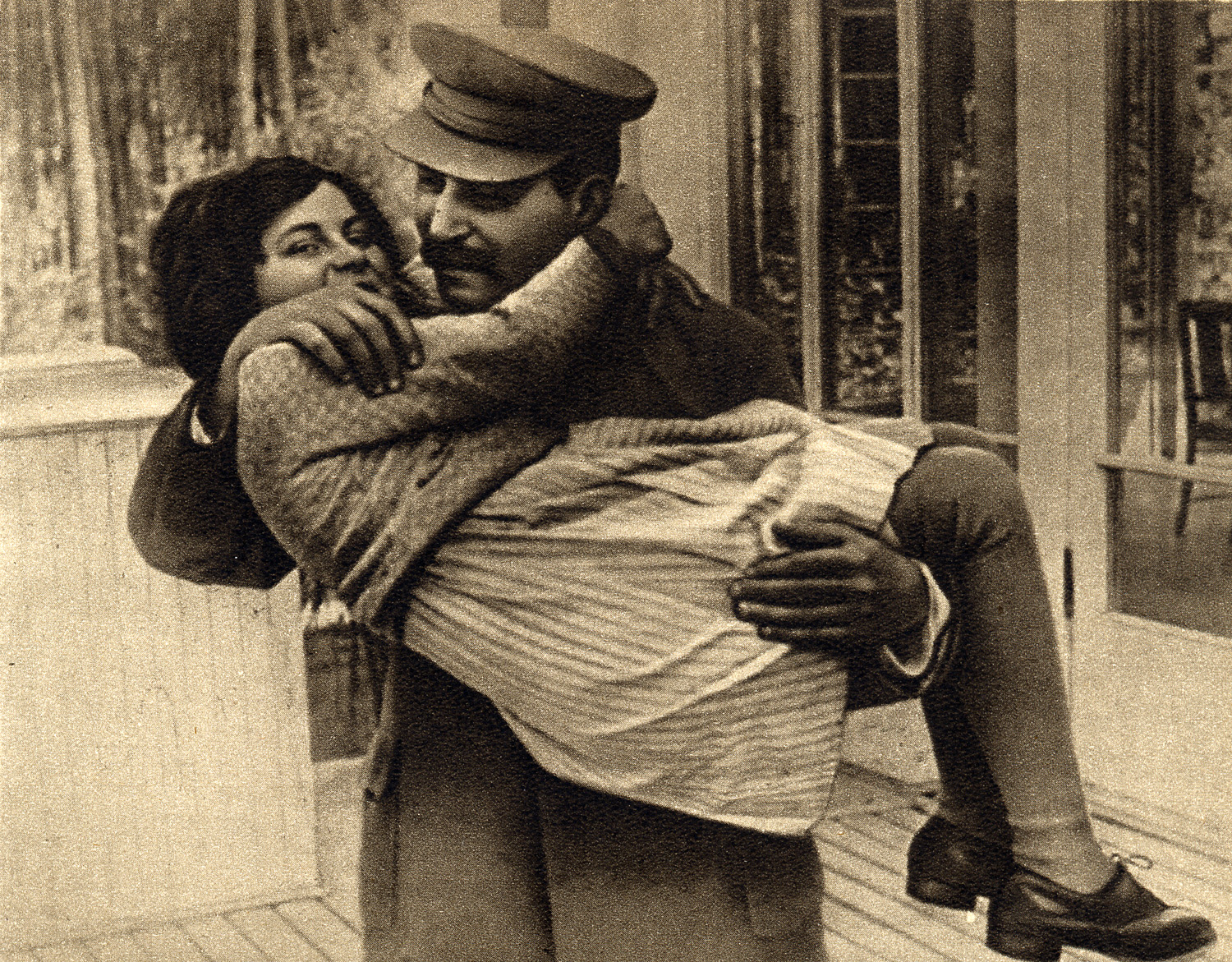22 November 2011 saw the death of Lana Peters in Wisconsin. To those who came into contact with her, she was simply a lonesome frail 85-year-old with a rather strange accent. But she was, in fact, once known by the name of Svetlana Stalin and she was the daughter of Joseph Stalin.
 Peters’ arrival in the US in 1967 (pictured) gave the West a huge propaganda coup – the defection of Stalin’s own daughter was the ultimate proof of how terrible life was behind the Iron Curtain. She had even been prepared to leave behind her two adult children, aged 22 and 17, in the Soviet Union.
Peters’ arrival in the US in 1967 (pictured) gave the West a huge propaganda coup – the defection of Stalin’s own daughter was the ultimate proof of how terrible life was behind the Iron Curtain. She had even been prepared to leave behind her two adult children, aged 22 and 17, in the Soviet Union.
‘I have come here to seek self-expression’
In her first US press conference, in 1967, she acknowledged the father’s monstrous rule but insisted that the blame for the murder of millions of Soviet citizens could not be laid purely on one man – it was the regime and its ideology. ‘I have come here to seek the self-expression that has been denied me for so long in Russia,’ she said. Shortly afterwards, she wrote Twenty Letters To A Friend, which went on to become a bestseller. A follow-up autobiography, Only One Year, sold equally well. With time she became more critical of her past – she publicly burnt her Soviet passport and accused her father of being a ‘moral and spiritual monster’.
In 1970, she married Wes Peters. Peters’ first wife had died in a car crash. She was also called Svetlana and her mother, the widow of the architect, Frank Lloyd Wright, saw in Alliluyeva a divine substitution for her deceased daughter. Under her urging, her new Svetlana and Peters married. They had one child, Olga, and although fond of each other, Svetlana Peters felt too suffocated by her husband’s former mother-in-law’s domineering presence and the marriage ended within three years.
Back in the USSR
In 1982, Peters and her daughter moved to Cambridge, England. Two years later, to the delight of the Soviets, she moved back to the USSR, wanting to be reunited with the children she had left behind 17 years before. Her life in the West, she told reporters, had not afforded her ‘one single day’ of freedom. Having had her Soviet citizenship restored, she lived in Tbilisi in Georgia. Stalin had been a Georgian but had felt little affinity for his homeland, spending his whole life as dictator cooped-up in the Kremlin. Peters had never been to Georgia and perhaps she felt the need to connect to her ancestral home. But life didn’t work out, she feuded with her family and after just two years, she requested to be allowed to leave again.
By 1984 she was back in the US and was never again to step on Russian soil.
 Nadezhda Alliluyeva
Nadezhda Alliluyeva
Svetlana was born 28 February 1926, the second child to Stalin and his second wife, Nadezhda Alliluyeva. Her brother, Vasily, was almost five years older. She also had a half-brother, Yakov, born 1907, a product of Stalin’s first marriage.
Being brought up in the stifling atmosphere of the Kremlin must have been difficult for a young girl. Her parents’ marriage was often strained and her mother, Nadezhda Alliluyeva, a manic depressive and prone to violent mood swings, never showed her any affection. In November 1932, when Svetlana was only six, her mother committed suicide. Nadezhda had had a public row with Stalin during a dinner party. In a foul mood, she retired to bed early and was found the following morning dead with a revolver at her side. History has always implied that Stalin was responsible for his wife’s death but eyewitnesses report his genuine grief and guilt – what had he done, he asked aloud, to have been so punished?
But Peters was never told that her mother had taken her own life, being fed the official line that Nadezhda had died from appendicitis. She only found out ten years later.
(Pictured – Stalin works while Svetlana sits on the knee of Lavrenti Beria)
Stalin died in 1953. Peters gave a graphic description of his final moments: ‘He suddenly opened his eyes and looked at everyone in the room. It was a terrible gaze, mad or maybe furious and full of fear of death… Then something incomprehensible and frightening happened. … He suddenly lifted his left hand as though he were pointing to something above and bringing down a curse on us all. … The next moment, after a final effort, the spirit wrenched itself free of the flesh.’
Following her father’s death, she took her mother’s name and became Svetlana Alliluyeva.
In 1963, Peters met Brijesh Singh, an Indian Communist visiting the Soviet Union. The two fell in love and although in a later interview she referred to him as her husband, they were never allowed to marry. Singh died in 1966 and Alliluyeva was at least permitted to take his ashes back to India. It was in India she embraced Indian mysticism and made the decision that she did not want to return to Moscow and a life of forced atheism. ‘It was impossible to exist without God in one’s heart,’ she said afterwards. She walked into the US embassy in New Delhi and requested asylum.
‘A very simple man’
 Of her father, Alliluyeva described Stalin in a 2010 interview as a ‘very simple man. Very rude. Very cruel. There was nothing in him that was complicated. He was very simple with us. He loved me and he wanted me to be with him and become an educated Marxist.’
Of her father, Alliluyeva described Stalin in a 2010 interview as a ‘very simple man. Very rude. Very cruel. There was nothing in him that was complicated. He was very simple with us. He loved me and he wanted me to be with him and become an educated Marxist.’
But like many a possessive father, that love was mixed with jealousy and paranoia as would be expected from the Twentieth Century’s most paranoid despot. She may have been his ‘little sparrow’ but as a young woman, Peters often fell in love with older and unsuitable men. One infamous case, in 1942, was that of Alexei Kapler. A dashing and confident 39-year-old, Kapler had made his name as a filmmaker and screenwriter and the previous year had won the much-coveted Stalin Prize.
Kapler was, in Peters’ words, ‘the cleverest, kindest, most wonderful person on earth’. He lent her risqué literature, novels and poetry full of love and yearning, and took her out to the cinema and galleries. Kapler was certainly brave – it takes a sort of perverse courage for a womanising, married man to seduce a 16-year-old girl, and to boast about it, when her domineering father is never too far away, especially when that father is Joseph Stalin. Sure enough, the inevitable happened. Stalin had had their telephone conversations taped and armed with the evidence he flew into a rage. It was bad enough that Kapler was married and old enough to know better, but what really irked was that Kapler was a Jew.
‘But I love him,’ protested Alliluyeva meekly. ‘Love?’ Stalin bellowed, slapping her twice across the face. Their relationship died that day. Kapler was arrested as a British spy and sentenced to five years, released, then promptly sentenced to another five.
‘My father’s name’
In the late forties, Peters married twice. Stalin disproved of her first husband, refusing to meet him, but he did allow the marriage to go ahead. It wasn’t to last. Nor would a second marriage to the son of Andrey Zhdanov, one of Stalin’s closest aides. Both marriages produced one child.
‘You can’t regret your fate,’ Ms. Peters once said, ‘although I do regret my mother didn’t marry a carpenter.’
She never truly found peace and never managed to escape her father’s shadow, ‘Wherever I go,’ she said, ‘I will always be a political prisoner of my father’s name’.
 Rupert Colley.
Rupert Colley.
Read more Soviet / Russian history in The Clever Teens’ Guide to the Russian Revolution (80 pages) available as paperback and ebook from Amazon, Barnes & Noble, Waterstone’s, Apple Books and other stores.